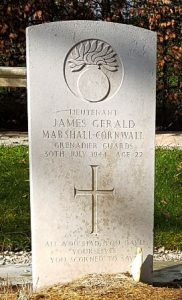Tregynon is a small village and community in Montgomeryshire, situated about four miles north of Newtown and nine miles south west of Welshpool, on the B4389 road which runs from Bettws Cedewain to New Mills. The men, and one woman, of Tregynon who fell during both World Wars are commemorated on the Parish War Memorial, which is situated within the grounds of St. Cynon’s Church. The memorial takes the form of a Celtic Cross, which is affixed onto a plinth which bears two plaques, one containing the names of the fallen of the Great War, another for those who fell in World War Two.
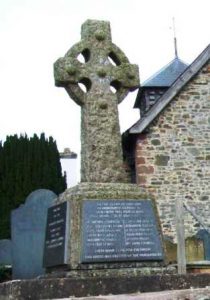
The Great War, 1914-1918
William Henry Corfield, Private, 1000065, Canadian Infantry. William was born on 26 May 1892, the son of Reuben and Helen Corfield, of Church House, Tregynon. He had emigrated to Canada prior to the war, where he gained work as a teamster. William enlisted into the 226th Overseas Battalion, Canadian Infantry at Virden, Manitoba on 3 December 1915, and sailed from Halifax for Liverpool with the battalion aboard the SS Olympic on 15 December 1916. William joined the Canadian Camp at Dibgate, where further training was carried out over the coming months. On 22 June 1917 William landed in France, joining the Canadian Base Depot, then on 11 July joined the 16th Battalion, Canadian Infantry, which was in the Arras sector at Neuville-St-Vaast, attached to the 3rd Brigade, 1st Canadian Division. Within days the battalion had moved to billets in Mazingarbe, and enjoyed a brief spell in reserve, before taking over a section of front-line in the Loos sector. The normal routines of trench rotation then followed over the coming weeks, with the battalion taking its turn holding the line, interspersed with periods in support and reserve, being broken by a large-scale assault by the battalion on Hill 70 on 15 August. On 5 September the battalion moved into the front line for a longer than normal tour, and endured a particularly hostile time over the coming days. On 14 September 1916 the battalion was still in the front line, when the battalion on their left flank launched a trench raid against the Germans, which the Germans promptly countered by opening up a terrible artillery barrage upon the Canadian lines. William was killed in action by artillery fire that day. The 28-year-old has no known grave and is commemorated on the Vimy Memorial, France.
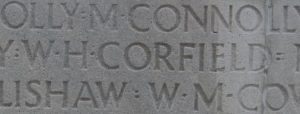
Thomas Griffith Evans, Private, 17377, King’s Shropshire Light Infantry. Thomas was the son of Thomas and Anne Evans, of Old School House, Tregynon. He married Elizabeth Ann Lloyd in 1911, and the couple resided at Concrete Cottage, Tregynon, where their daughter Marian was born. Thomas enlisted into the King’s Shropshire Light Infantry at Shrewsbury soon after the outbreak of war, and was posted to the 5th Battalion, KSLI. The battalion had formed at Shrewsbury in August 1914, before joining 42 Brigade, 14th (Light) Division at Aldershot. On 20 May 1915 the Division landed at Boulogne, and proceeded to the Zillebeke area, some two miles SW of Ypres, taking over a section of the front line there by 31 May for instruction alongside the 5th Division, and began wiring work, improving the defences of the trenches. By 16 June the Division had moved slightly north, taking over its own section of the front east of Ypres, in the notorious Hooge sector. The Division was to gain an unwanted place in the history books here when, on 30 July 1915, the Germans attacked their front using newly developed flame-throwers, the first time such a terrifying weapon had been used in action. During terrible fighting, the Germans captured the Divisional front-line, and beat off a counter-attack, in which the 5th KSLI were involved. The Division then began work improving the new front line before being relieved and moving into support at Vlamertinghe to rebuild. By 23 August the Division had moved back into the line, and began work preparing for a diversionary attack, the Second attack on Bellewaarde, which was to be launched on the same day as the Battle of Loos, to the south, and was intended to divert German attention away from the Loos offensive. At dawn on 25 September 1915, the 5th KSLI launched a frontal assault against the German positions at Bellewaarde, but suffered terrible casualties in doing so. Thomas was among over 400 casualties suffered by the battalion alone that day. The 29-year-old has no known grave and is commemorated on the Ypres (Menin Gate) Memorial, Belgium.
Frank Richard Hawkins, Private, 123274, Machine Gun Corps. Frank was the son of Alfred William Hawkins and Sarah Eliza Hawkins (nee Morris), of Cocksidan, Tregynon. He worked as a farm labourer prior to enlisting into the army at Welshpool. Frank was drafted to France, joining the 24th Battalion, Machine Gun Corps. The battalion had been formed at Devise, France from the 17th, 72nd, 78th and 191st Companies, MGC on 5 March 1918, attached to the 24th Division. The Company then moved into the section of front line running from Jeancourt-Le Verquiet-Vadencourt-Maissemy, facing the Hindenburg Line. The men holding the front line could hear lots of movement going on behind the German held lines, and it was well known amongst the troops that a German offensive was imminent. At dawn on 21 March 1918, the Germans opened up a tremendous artillery bombardment along the section of Western Front running south from Croisilles to La Fère, then out of the mist, thousands of highly-trained specialist German stormtroopers attacked the weakened Allied lines. The machine-gunners of the 24th Battalion, MGC manned their gun positions, and soon received news that the 66th Division on the left flank was under attack. Soon the Division came under attack, and the machine-gunners opened up a barrage fire onto the German lines. Heavy fighting soon ensued, and at some time during the day, Frank was killed in action. The 24-year-old has no known grave and is commemorated on the Pozieres Memorial, France.
David Frederick Jones, Private, 60748, Welsh Regiment. David was the son of Frederick Jones and Margaret Jones (nee Humphreys), of Tynycoed, Cyfronydd, Castle Caereinion. He worked for the Cambrian Railways prior to enlisting at Wrexham into the Royal Welsh Fusiliers. After completing his training, David was drafted to France, and was transferred to the 14th Battalion, Welsh Regiment, which was attached to 114 Brigade, 38th (Welsh) Division. He probably joined the battalion near Armentieres, where it was rebuilding following heavy losses at Ypres, especially during the assault of the 38th (Welsh) Division on the Pilckem Ridge on 31 July. The Division held a section of front line here until the end of March 1918, when it was transferred south to the Somme sector, to relieve the battered 2nd and 47th Division in the line facing Bouzincourt Ridge, following their withdrawal in front of the German offensive. By 12 April the 14th Welsh had taken over a section of the Divisional front, and began the usual routine of trench rotation, before being relieved on 19 April, moving into Brigade reserve. David was wounded during this period and was evacuated to the 130th Field Ambulance at Warloy-Baillon, where he died of his wounds on 23 April 1918, aged 19. He is buried in Warloy-Baillon Communal Cemetery Extension, France. He is also commemorated on the Cambrian Railways Memorial, Oswestry.
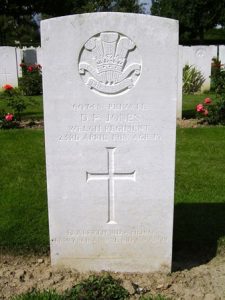
Edward Maldwyn Jones, Private, 37105, Royal Welsh Fusiliers. Edward was the son of David and Jane Elizabeth Jones, of Middle Rhiwhiriaeth, Llanfair Caereinion. He worked as a wheelwright prior to enlisting into the Royal Welsh Fusiliers at Welshpool on 22 November 1915, and was posted to the Depot at Wrexham, before joining the 3rd RWF at Litherland Camp, Liverpool for training. On 26 April 1916 Edward embarked at Southampton aboard the SS Copenhagen for France, joining the 2nd Infantry Base Depot at Rouen. On 7 May 1916 he was posted to the 2nd Battalion, Royal Welsh Fusiliers, which was in Flanders attached to 19 Brigade, 33rd Division. The Division endured a hard time in the line there, holding such notorious sectors as Cambrin and Cuinchy, where underground warfare was prevalent. Soon after Edward joined the 2nd RWF, on 22 June 1916 the Germans exploded a massive mine beneath the position held by B Company, 2nd RWF, which killed 54 men of the battalion, as well as trapping a number of British tunnellers underground. During the attempted rescue of one tunneller, a soldier of the 14th Welsh, Sapper Hackett was awarded the VC. At the beginning of July, the 33rd Division moved out of the sector and began to move into the Somme area. By 16 July the 2nd RWF were bivouacked in the newly captured Mametz Wood, and moved to Bazentin-le-Petit two days later, to take part in the assault on High Wood. The battalion suffered heavy casualties at High Wood, and moved back into reserve at Buire-sur-L’Ancre until 6 August and then spent several days at Becordel before moving back into the line at High Wood on 18 August, and helped beat off a German counter-attack. Edward was killed in action during the following day, 19 August 1916. The 19-year-old was originally buried on the battlefield, but after the war his grave was located, and his remains were re-interred in Serre Road Cemetery No.2, France.
Christmas Gordon Lewis, Gunner, 218845, Royal Garrison Artillery. Christmas was the son of Richard and Mary Lewis, of Bettws. He worked on his parent’s farm prior to enlisting into the Royal Garrison Artillery at Wrexham on 3 June 1918, and was posted to No 1 Depot at Derby for training. Christmas was then sent to the 3rd Siege Artillery Brigade at Prees Heath, Shropshire. He took ill soon after arriving at Prees Heath, and was taken to Prees Heath Military Hospital, where he died of pleurisy and double pneumonia on 23 June 1918. The remains of the 22-year-old brought home for burial in Gerizim Calvinistic Methodist Chapelyard, Tregynon. Christmas is not commemorated on the Tregynon war memorial.
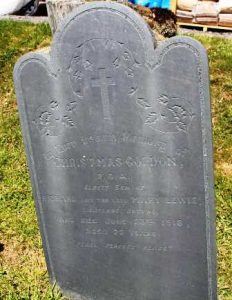
Edward Pugh Lewis, Second Lieutenant, Royal Flying Corps. Edward was born in 1897, the son of Evan and Jane Lewis, of Argoed, Tregynon. He was educated at the University of Wales, Aberystwyth, and was commissioned from the OTC on 20 April 1917 into the Royal Flying Corps. Edward was posted to the 9th Squadron, Royal Flying Corps in France. On 6 October 1917, Edward was flying in an R.E.8., Serial B5039, artillery spotting over the Ypres battlefield, when a shell hit their aircraft, sending it crashing near the ground. Edward and his pilot, Lieutenant Holt, were killed in the crash. Edward was 20 years old, and is buried in Mendinghem Military Cemetery, Belgium.
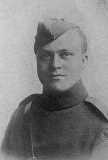
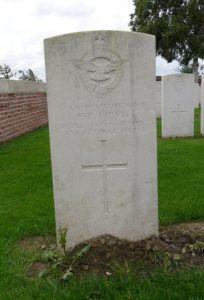
John Edward Oliver, Private, 203539, Royal Welsh Fusiliers. John was the son of John and Sarah Oliver, of Fair View, Tregynon. He worked as a Waggoner prior to enlisting into the 4th (Reserve) Battalion, Royal Welsh Fusiliers at Welshpool on 3 June 1916, and was initially placed on the Army Reserve. John was mobilised on 19 January 1917, and was probably posted to Park Hall, Oswestry for training. He embarked at Southampton for Egypt on 12 July 1917, and upon arrival in Egypt was posted to the 24th Battalion, Royal Welsh Fusiliers. The battalion had been formed from the Denbighshire Yeomanry in Egypt on 1 March 1917, joining 231 Brigade, 74th (Yeomanry) Division, and saw its first major action during the Second Battle of Gaza on 17 April. The battle was a failure, and the EEF was re-organised under a new commander, Sir Edmund Allenby, before launching the Third Battle of Gaza on the night of 31 October 1917. This assault was launched along a winder front, running from Gaza to Beersheba, and this time the EEF prevailed, opening the door to Jerusalem. John had been killed in action during the assault that day. The 19-year-old was buried by Reverend Sommerville in Beersheba War Cemetery, Israel.
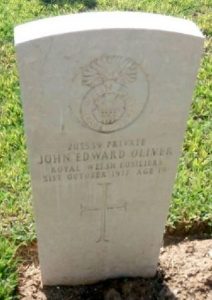
Benjamin Phillips, Private, 355461, Royal Welsh Fusiliers. Benjamin was the son of Benjamin Phillips and Mary Ann Phillips (nee Breese), of Melinygloch, Aberhafesp. He worked as a labourer at Bettws prior to the war. Benjamin enlisted into the 3/1st Battalion, Montgomeryshire Yeomanry at Newtown on 11 December 1915 and was placed on the army reserve until being called up soon afterwards, on 22 January 1916. Benjamin joined the battalion at Oswestry, and after completing his training, embarked at Devonport for Egypt on 12 January 1917. Benjamin joined the 1/1st Battalion, Montgomeryshire Yeomanry on the Suez Canal defences. On 4 March 1917 the battalion merged with the Welsh Horse Yeomanry to form the 25th (Montgomery & Welsh Horse Yeomanry) Battalion, Royal Welsh Fusiliers, as part of the newly formed 231 Brigade, 74th (Yeomanry) Division. The Division then fought through the Palestinian Campaign, at the Battles of Gaza and the Battle and capture of Jerusalem. Due to the terrible casualties suffered by the British on the Western Front in March and April 1918 the Division was recalled to the Western Front, and arrived at Marseilles during May 1918. The Division trained near Le Cauroy before taking over positions in the St. Floris Sector, moving into the front line between the La Bassée Canal and the River Lys, with the left resting on the small village of Corbie. The Division faced the recently lost town of Merville, some 3,000 yards away. Benjamin was wounded when his battalion was following up a German withdrawal on 18 August. He was evacuated to the 39th Stationary Hospital at Aire, where he died of his wounds on 19 August 1918, aged 25. Benjamin is buried in Aire Communal Cemetery, France. His mother had by then moved to Ocean View, Dyffryn, Merionethshire.
Henry Ellis Phillips, Private, 43746, Royal Welsh Fusiliers. Henry was the son of Benjamin Hudson Phillips and Elizabeth Phillips, of Temperance Hotel, Tregynon. He lived at The Revel, Berriew prior to the war, where he worked as a Butcher. Henry enlisted into the 3rd Battalion, Royal Welsh Fusiliers at Welshpool on 12 February 1916. He was initially placed on the Army Reserve, before being mobilised on 2 June 1916 and sent to Litherland Camp, Liverpool for training, after being rejected for the Royal Flying Corps. On 3 October 1916 Henry embarked for France, initially destined to join the 1st Battalion, Royal Welsh Fusiliers, but was instead posted from the 5th Infantry Base Depot to the 13th Battalion, Royal Welsh Fusiliers, which was at Ypres attached to 113 Brigade, 38th (Welsh) Division. The Division had moved to the Ypres Salient, taking over the Canal Bank sector at Boesinghe, following its epic assault on Mametz Wood during the Somme offensive. The infantry battalions of the Division then began carrying out the normal pattern of rotation in the trenches, four days in the front, four in support and four in reserve, whilst also working on trench improvement, digging new trenches, and also carrying out regular patrols and trench raids. On 31 July 1917 the Division launched its famous assault on the Pilckem Ridge, capturing Iron Cross and reaching its objective of the Steenbeek, then played a supporting role in the Battle of Langemarck. The Division was transferred to the Sailly-sur-la-Lys sector in September, and remained in the area over the winter before being moved to positions north of Albert, at Bouzincourt Ridge, at the end of March 1918, relieving the battered 2nd and 47th Divisions. On 21 April, 113 Brigade moved into the line, in readiness for an assault, to attempt to gain the high ground of Bouzincourt Ridge. As the men leapt over the top of their trenches on 22 April, they were immediately hit by concentrated machine-gun fire. The supporting artillery barrage proved inadequate, and many casualties were suffered, before the brigade was forced to withdraw. Henry was wounded during the attack of 22 April and was evacuated to the 3rd Canadian Stationary Hospital at Doullens, where he died of his wounds on 25 April 1918, aged 25. He is buried in Doullens Communal Cemetery Extension No. 1, France.
John Edward Pritchard, Lance Sergeant, 355302, Royal Welsh Fusiliers. John was the son of William and Elizabeth Pritchard of Dingle Cottage, Abermule. He worked for Mr. Gethin at Tynybryn, Tregynon prior to enlisting into the 1/1st Battalion, Montgomeryshire Yeomanry at Welshpool on 28 September 1914. On 5 August 1914 the Montgomeryshire Yeomanry had mobilised at Welshpool, as part of the South Wales Mounted Brigade, before moving via Hereford to Thetford, to join the 1st Mounted Division. On 4 March 1916 the 1st Mounted Division sailed for Egypt to join the EEF. On 4 March 1917 the battalion merged with the Welsh Horse Yeomanry to form the 25th (Montgomery & Welsh Horse Yeomanry) Battalion, Royal Welsh Fusiliers, as part of the newly formed 231 Brigade, 74th (Yeomanry) Division. The Division did not take part in the disastrous First Battle of Gaza, as it was not ready, but took part in the second attempt to take the coastal city, which was launched on 17 April 1917, but also failed, and the EEF suffered a change in leadership, with Sir Edmund Allenby assuming command, before being re-organised, and a third offensive was launched against a wider front from Beersheba to Gaza on 31 October 1917. This time the Turkish defences were breached, and the road to Jerusalem now lay open. John was killed in action during this successful Third Battle of Gaza, on 31 October 1917. The 27-year-old is buried in Beersheba War Cemetery, Israel.
Joseph Edward Pugh, Private, 26309, Royal Irish Regiment. Joseph was the son of Joseph and Elizabeth Pugh, of Caepcappin Cottage, Tregynon. He married Sarah Eleanor Morgan in 1912, and the couple lived at Tanybryn, Sarn, where their only child, Joseph, was born the following year. Joseph enlisted into the army at Shrewsbury, and was initially posted to the 10th Battalion, Royal Dublin Fusiliers. The battalion landed at Le Havre on 19 August 1916, joining 190 Brigade, 63rd (Royal Naval) Division and saw its first action during the Second Battle of Passchendaele. The Divisions next major action was at Cambrai, during the Action of Welch Ridge, and it was still in the area when the Germans launched their Spring Offensive of 21 March 1918, seeing heavy casualties over the coming days. Joseph was transferred to the 7th Battalion, Royal Irish Regiment later that year. The battalion had formed in France on 1 September 1917 from the dismounted 1st and 2nd South Irish Horse, joining 49 Brigade, 16th (Irish) Division at Ervillers. Following heavy losses during the German Spring offensive of 21 March 1918, the battalion was reduced to a cadre, but on 26 June 1918 was reformed with 500 men of the Royal Dublin Fusiliers, 250 from the Royal Munster Fusiliers and 85 from the Royal Irish Regiment, before joining 21 Brigade, 30th Division at Hellbroucq. On 8 August the Division moved into the line at Boescheppe, and Joseph’s new battalion was kept busy, improving the trenches and wiring. To the south, the Allies launched a general offensive on 21 August, and began driving the Germans back towards the Hindenburg Line. On 30 August the Germans in front of the 30th Division was found to have withdrawn, and patrols were sent out to ascertain the situation. The Division then began to cautiously advance, reaching the Dranoutre to Neuve-Eglise Road, clearing the latter village two days later. This advance in Flanders continued over the coming days, with the infantry battalions of the Division taking turns leading the advance. The 7th Royal Irish saw heavy fighting during the attack on Wervicq on 13-14 October, reaching Zandvoorde on the 16th. The battalion had a brief rest before resuming the advance on 21 October, crossing the River Escaut and reached St. Genois the following day. Joseph had been wounded during this period, and was evacuated to Hazebrouck, where he died of his wounds on 25 October 1918. The 30-year-old is buried in La Kreule Military Cemetery, Hazebrouck, France.
Richard John Thomas, Private, 355510, Royal Welsh Fusiliers. Richard was the son of Edward Thomas and Elizabeth Thomas (nee Watkin), of The Smithy, Tregynon. He followed his father into the Blacksmiths trade, and trained with him before taking over the family business. Richard had enlisted into the Montgomeryshire Yeomanry at Newtown on 20 April 1909, and had attended the annual territorial summer camp every year thereafter. On 5 August 1914 the Montgomeryshire Yeomanry was mobilised at Welshpool, as part of the South Wales Mounted Brigade, before moving via Hereford to Thetford, to join the 1st Mounted Division. Richard married Blodwyn Jervis at Tregynon on 9 July 1915. By 5 May 1916 Richard had completed his service with the Territorials, but on 5 September was recalled to the Colours, re-joining the Regiment again, and being given the rank of Farrier Sergeant. By now the Regiment was in Egypt with the 1st Mounted Division, having joined the EEF, and had dismounted, having been converted to infantry. On 12 January 1917 he embarked at Devonport, and disembarked at Alexandria 18 days later, joining the 1/1st Battalion, Montgomeryshire Yeomanry soon afterwards. On 4 March 1917 the battalion merged with the Welsh Horse Yeomanry to form the 25th (Montgomery & Welsh Horse Yeomanry) Battalion, Royal Welsh Fusiliers, as part of the newly formed 231 Brigade, 74th (Yeomanry) Division. The Division assembled in Egypt as part of the EEF, before crossing the Suez Canal into the Sinai, and saw its first major action during the Second Battle of Gaza. The battle was a failure, and the EEF was re-organised under a new commander, Sir Edmund Allenby, before launching the Third Battle of Gaza on the night of 31 October 1917. This assault was launched along a winder front, running from Gaza to Beersheba, and this time the EEF prevailed, opening the door to Jerusalem. The Division then took part in the drive north into Syria, but as a result of the heavy losses suffered in France, following the launching of the three German Spring offensives from 21 March 1918, was sent to France, landing in Marseilles on 7 May 1918. The Division trained near Le Cauroy before taking over positions in the St. Floris Sector, moving into the front line between the La Bassée Canal and the River Lys, with the left resting on the small village of Corbie. The Division faced the recently lost town of Merville, some 3,000 yards away. To the south, the Allies launched their offensive on 21 August 1918, and began the great advance towards the Hindenburg Line. In September the Division moved south to the Somme sector, to join the great offensive, and on 18 September took part in an assault on positions near Lempire and Ronssoy, which formed part of the outer defensive line for the Hindenburg Line. After suffering heavy casualties, especially around Orchard Post and Gillemont Farm, the Division then attacked the Quadrilateral defences, suffering heavily again before being relieved on 24 September and entrained at Péronne for northern France once more. The Division then took part in the Advance in Flanders. By the morning of 18 October, the 25th RWF had received orders to carry the advance to the village of Sainghin, coming under heavy machine-gun fire before forcing a crossing of the Marcq River. The battalion consolidated and spent the night at Sainghin Wood, before advancing on Chapelle Bouchery the following day, pushing forwards to the village of Camphin. The battalion established a line East of Camphin before night fell, and on the following morning advanced again from this new line. Richard was killed in action during this assault on 20 October 1918, just hours before the battalion was relieved. The 35-year-old was buried in Lamain Communal Cemetery, Belgium.
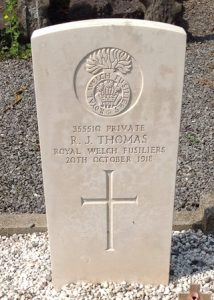
World War Two, 1939-1945
William Edward Astley, Gunner, 1492596, Royal Artillery. William was the son of Thomas Astley and Florence Edith Astley (nee Thomas), of Tregynon. He enlisted into the Royal Artillery, and was posted to the Far East, to join 9 Coast Regiment, Royal Artillery, which formed part of the huge Singapore Garrison. Singapore was known as the ‘Gibraltar of the East’, was the most important British base in South-East Asia and the South-West Pacific. On 8 December 1941 the Japanese launched an amphibious invasion of Malaya and Thailand, in conjunction with their assault on Pearl Harbour, and within hours Thailand surrendered. Allied troops fought a desperate defensive action in Malaya, but were overwhelmed by the superior number of Japanese forces, who also had much better aircraft available. On 8 February 1942 the Japanese began their invasion of Singapore, with a force of around 30,000 troops, compared to the garrison’s strength of around 85,000. The command of the garrison was poorly led, and within a week Singapore capitulated, with General Percival surrendering on 15 February 1942, leading to the surrender of 80,000 troops. The capitulation was described by Winston Churchill as the ‘worst disaster in British military history’. Just before the surrender, the Coastal Batteries had been destroyed, and by 13 February the gunners had been marched to the Indian Recreation Ground in Singapore where they were formed into an Infantry Battalion and used as support troops. William was taken prisoner by the Japanese following the surrender, and was incarcerated at the notorious Kranji Jail. He died in captivity on 12 September 1941. The 23-year-old was buried in Kranji War Cemetery, Singapore.
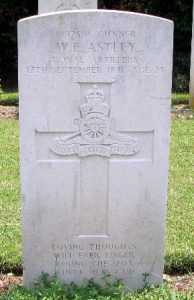
Joyda Howell Davies, Aircraftman 2nd Class, 1409059, Royal Air Force Volunteer Reserve. Joyda was the son of Howell Davies and Mary Jane Davies (nee Evans), of Cream Cottage, Tregynon. He enlisted into the Royal Air Force Volunteer Reserve, and was posted to the Far East with 605 Squadron, RAF. The squadron had formed at RAF Castle Bromwich on 5 October 1926, as a day bomber unit of the Auxiliary Air Force, but was then re-designated as a fighter-squadron, and had re-equipped with the Hawker Hurricane just prior to the outbreak of war. The Squadron then moved to RAF Tangmere, having postings in Scotland, before returning south and took part in the Battle of Britain. In the Winter of 1941, the Squadron was posted to the Mediterranean, and in November 1941, flew off the carrier HMS Argus to Malta, where it became part of the island’s defences, before embarking for the Far East, but arrived at Singapore too late to prevent its capture, so was moved to Sumatra and then to Java. Unfortunately, the squadron was caught up in the Japanese invasion of Java, where many of its personnel were captured. Joyda was amongst the men taken prisoner by the Japanese following the fall of Java, and was sent to a PoW Camp in Thailand. He died of dysentery on 23 July 1943 whilst in captivity. The 22-year-old was originally Buried at Hintok Valley Camp No 1, but after the war his grave was exhumed, and he was re-interred in Kanchanaburi War Cemetery, Thailand.
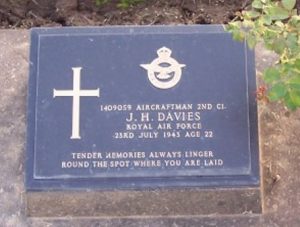
Elinor Elsbeth Herbert-Jones, Civilian. Elinor was the daughter of Captain Herbert Jones, and of Deborah Jarrett Herbert Jones (nee Rowlands), of Bron-Bechan, Tregynon. She was in New Zealand when war was declared, and bought passage for Britain, sailing from Auckland for England on Sunday 24 November 1940 aboard the liner RMS Rangitane. The ship carried a large cargo including foodstuffs and silver bullion, as well as 111 passengers, including nurses, Polish sailors, servicemen and radar technicians. On 27 November 1940 the liner was some 300 miles east of New Zealand, when she was intercepted by the German surface raiders Komet and Orion. The Germans signalled the liner to stop, whereupon her Captain signalled for help, prompting the Germans to fire at her. Rangitane was soon badly damaged, and suffered a loss of steering, so was helpless. After a brief attempt to escape the situation was soon realised to be hopeless, so her Captain gave the orders to abandon ship. Elinor was among 32 people killed in the attack. The survivors were taken by lifeboat to the German ships. Elinor was 21-years-old when she was killed in the attack, and is commemorated by the CWGC in the Civilian War Dead Register at Westminster Abbey. Her mother was a renowned pioneer of women in broadcasting, becoming one of the most prominent Welsh women of the Twentieth Century.
James Gerald Marshall-Cornwall, Lieutenant, 255169, Grenadier Guards. James was the son of General Sir James Handyside Marshall-Cornwall, KCB, CBE, DSO, MC, and of Lady Marjorie Coralie Marshall-Cornwall (nee Scott-Owen), of Tregynon and of Chelsea. He was educated at Eton, and became an Officer Cadet before being commissioned as Second Lieutenant into the Grenadier Guards on 5 December 1942, and was posted to the 4th Battalion, Grenadier Guards. During the previous year, the 4th Battalion, which had been reformed for war, had become mechanised, equipping with the Churchill Tank, and joined the 6th Guards Tank Brigade Group. On 20 June 1944 the Brigade landed on the beaches of Normandy, as part of XXX Corps, to take part in the break-out from the beach-head. The Brigade saw its first major action during Operation Goodwood, as part as the Battle for Caen, and then took part in the subsequent Operation Bluecoat, which was to take place in the infamous Bocage. On 30 July 1944, the 6th Guards Tank Brigade lead an assault by the 15th (Scottish) Division, on the right flank of the operation, and attacked a German position south and east of the village of Caumont. James, by now a Lieutenant, was commanding the leading tank of his group, and captured the Bois de Mondany. Whilst handing over prisoners to the supporting infantry of the 2nd Gordon Highlanders, James was shot dead by a German sniper. The 22-year-old was buried on the spot where he fell, in an isolated grave near Cahagnes. After the war his father requested that his grave was left where it was, and not concentrated into one of the larger Normandy cemeteries, so James still lies there today.
